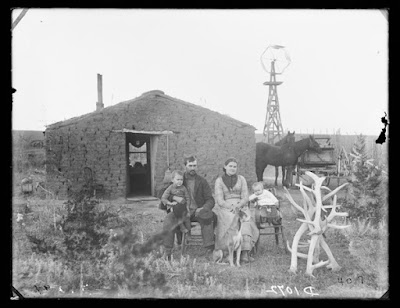"If, in looking over the pages of this book, you find a fuller description of some other portion of the county than your own, pause before criticising the historian and ask if it is not your own fault that you are not more fully represented. If you have done any great deeds in Custer County which are worthy to go down in history, was it not your duty to have them recorded?"
--S. D. Butcher, Pioneer History of Custer County and Short Sketches of Early Days in Nebraska (1904)
Introit
They seem relaxed and composed, this family,
as they have their picture made
in front of their sod house
by the nomadic photographer.
The husband, with his hat on one knee
and his oldest on the other.
His dog in front and horses behind
with that blasted, blessed windmill
that took two months to build and another
two for the well.
The wife, with her hair pulled back
and her youngest in a tall chair.
Her broom by the open front door
so that you can see her prized glass window
that they packed in two quilts for the
wagon ride from Kearney.
Adagio
I have to wonder how they met:
the photographer and the family.
Did he ride over the hill
and catch them tinkering on the windmill
and mending pants?
Or, did he give them the hard-sell
at the hardware store in town
or at church?
Was this a photo they wanted to take
or are they seething inside at their inability
to say 'no' to a salesman?
How long did they wait before they saw
their photo? Were they all alive the next time
he came calling to sell them this mirror of their life?
I say this only by pretending I was the oldest boy
in the photo, and by thinking about my family:
but, I bet the previous day was nothing
like the quiet scene of the photo.
Especially if the man came home and told
his wife that he had hired the photographer to stop by
the next day.
Dusting and swearing and sweeping and shouting
and washing and crying.
But, it is clear that peace came back to the valley,
at least until the photographer left.
My money says the wife's smile
is hiding something.
Trionfante
Those gleaming antlers seem purposefully
piled to talk to a father-in-law who
opened a parcel on a rainy afternoon in St. Josephto reveal a copy of this photo.
The attached letter probably said
"We are doing well" and described the new wellin detail, and also the garden and the field
plowed to hold the claim.
Unwritten: your daughter has
meat to eat.
Finale malinconico
We have friends who send us their family photos
for Christmas.
Some wear shirts all of the same color, and I imagine that half
have never worn that color before.
Some stand in front of a mountain or a beach to
show how far they can go from their home.
Some relax in casual clothes, under an unfamiliar tree in
a park that the photographer suggested.
I think about this Butcher photo of the family from
Custer County as I leaf through our Christmas cards
and how far we have come from those days
of living in a sod house on 160 acres.
How far we have come from a time when a
pile of elk antlers, two horses, a smiling wife,
two babies, a broom, a wagon, and a windmill
could tell the world
that your dream was still alive.
L. Powell, 15 January 2011
Kearney, NE



